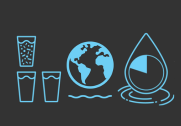Water Purification
The Importance of Green Chemistry in Addressing Global Freshwater Shortages
Removal of Emerging Contaminants in Wastewater Using Biocatalysis Assisted by Electrochemical Process
Electrochemical methods like electrocoagulation (EC) can remove a vast array of compounds from wastewater but are not ideal for emerging pollutants found at low concentrations (ng/L to μg/L). In contrast, enzymes are known to effectively target these pollutants, but their performance can be hindered in complex water matrices. This work explores a biocatalytic treatment assisted by electrochemical processes to remove two emerging pollutants, Bisphenol A (BPA) and Triclosan (TCS) from municipal wastewater.
Synthesis of Iron-Based Nanomaterials for Pharmaceutical Degradation in Water
This work aims to study the degradation of commonly used pharmaceutical contaminants in Chile through the Heterogeneous Solar Photo-Fenton process, utilizing nanometric-sized spinel ferrites as catalysts. Specifically, manganese ferrites (MnFe₂O₄), copper ferrites (CuFe₂O₄), and cobalt ferrites (CoFe₂O₄) will be synthesized, along with graphene-supported ferrite composites. The size, chemical composition, and morphology of these nanomaterials will be characterized.
In-situ monitoring for the role of dye structure on electrochemical decolorization
The widespread use of synthetic dyes has led to the release of substantial amounts of dye-contaminated wastewater, posing significant environmental and health concerns. This study focuses on the use of anodic and electrochemically activated persulfate oxidation for the degradation of organic contaminants. Specifically, the structural variations of nine dyes in the indigoid and azo families, and their impact on the efficiency of electrochemical oxidation were analyzed. An in situ continuous monitoring apparatus with a UV-visible detector was employed to collect data in real-time.
EPA Report on PFAS Strategic Roadmap: Three Years of Progress
The Environmental Protection Agency (EPA) has released a comprehensive report detailing three years of progress on its PFAS Strategic Roadmap, originally introduced in 2021 to tackle per- and polyfluoroalkyl substances (PFAS) contamination across air, land, and water. The Roadmap is built on three core objectives:
Models to Predict the Removal of Emerging Micropollutants from Water by Novel Adsorbents in Fixed-Bed Column Processes
The U.S. Environmental Protection Agency (EPA), through the Innovative Water Technology Grant Program, is seeking applications for research to develop, test and deploy predictive models for novel adsorbents and estimate the effectiveness of these adsorbents to remove emerging micropollutants in drinking water and wastewater treatment operations.


